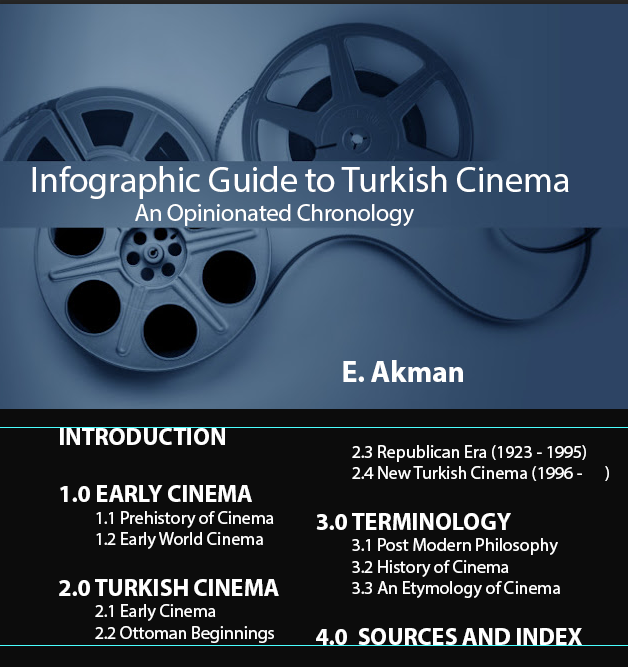In general, the same periods were repeated in similar forms in other
books:
1- The Early Years / Ottoman Period
2- Theater Players / Muhsin Ertuğrul
Period
3- Intermediate Period / Transition Period
4- 1950-70 Filmmakers Period
5- After 70 / Contrast (Karşıtlıklar) Period
6- After 80 / Coup Period
7- After 90s
8- New
Turkish Cinema
Another Periodi classification is by Rıdvan ŞENTÜRK
Source: The Periodization Problem in Writing The Turkish Cinema History Prof. Dr. Rıdvan ŞENTÜRK
Classical/Analog Period:
1896-1922: First Period (The
introduction of cinema to the Turkish/Ottoman geography and its development
process).
1923-1927: Second Period (Proclamation of the Republic, revolutions
in clothing, art, education, culture and law).
1928-1938: Third Period
(Alphabet and language revolution, prohibition of teaching Turkish music in
schools and broadcasting on the radio, declaration of the Regulation on
Censorship of Motion Pictures, transition to the sound film era).
1939-1949:
Fourth Period (Proclamation of the Regulation on Censorship of Films and Film
Scripts, beginning and end of World War II, attempts to transition to a
multi-party system).
1950-1959: 5th Period (1950 elections, implementation of
the multi-party system, changes in social and cultural policies, increasing
urbanization rate, transition to color film era).
1960-1969: 6th Period (1960
coup, changes in social and cultural policies, acceleration of urbanization
process, transfer of radio broadcasts to TRT, start of television broadcasts).
1970-1979: 7th Period (1971 Army Memorandum, increasing ideological
polarization, civil war environment, transition to uninterrupted television
broadcasts, spread of arabesque music culture).
1980-1989: 8th Period (1980
coup, reduction of the tax collected from foreign films from 50% to 25%,
enactment of the law foreseeing an increase from 0% to 25% on domestic films
and the Law on Cinema, Video and Musical Works, liberalization in social,
economic and cultural policies, acceleration of the urbanization process,
beginning and acceleration of separatist terrorist incidents).
1990-1999: 9th
Period (acceleration of the liberalization process in social, economic and
cultural policies, acceleration of the urbanization process, establishment of private
television channels, increase in separatist terrorist incidents, February 28
intervention, widespread use of video/DVD technology, beginning of use of the
internet).
Digital Period:
2000-2009: Period 1 (Transition to digitalization in
cinema, economic crisis, continuing liberalization process in social, economic
and cultural policies, increasing separatist terrorist incidents, increasing
number of private channels, widespread use of satellite and cable TV
broadcasting, widespread use of the internet, continued widespread use of DVD
technology, revival of television series sector, widespread use of mobile
phones, tablets and laptop computers, emergence of small and easily portable digital
film and photo cameras).
2010- 2019: 2nd Period (DVD technology weakening,
satellite and cable TV broadcasting, internet, mobile phones, tablet and laptop
computer usage continuing to spread, small and easily portable digital film and
photo cameras becoming more affordable and widespread, television series sector
developing further and showing export success abroad, separatist terrorist
incidents continuing to increase, civil wars and occupations in Turkey's
immediate vicinity and North African countries, July 16 coup attempt,
transition to presidential system).
2020- Ongoing Period
1 Poet, Writer. Producer and director at “Atlantik Media and Production” company,
ozkankaraca@atlantikmedya.com
2 Nijat Özön, History of the Art of Cinema Application, Hil Publications, Istanbul, 1985. p.333.
[*]Alim Şerif Onaran (1924, Kula Manisa - 11 August 2000, Istanbul) was a Turkish cinema theorist, writer, academic and lawyer. He also had the title of being the first cinema professor in Turkey. He played a pioneering role in the schooling of cinema in Turkey.
[**] Nijat Özön (December 25, 1927, Istanbul - December 15, 2010, Ankara) is a Turkish cinema critic and theorist, translator, and linguist. Özön, who published the first periodical about cinema in Turkey, also wrote the first cinema encyclopedia.
[3] (İsmail) Metin Erksan (1 January 1929 – 4 August 2012) was a
Turkish film director and art historian.
Metin Erksan gained success with films depicting the problems of people from the countryside he adopted from the literature. Susuz Yaz won the Golden Bear Award in Berlin, Germany. Yılanların Öcü (1962) was awarded in 1966 at the Carthage Film Festival in Tunisia. He was named "Best Director" with his film Kuyu (1968) at the first edition of International Adana Golden Boll Film Festival. Along with renowned film director Halit Refiğ, he was credited as the representative of the national cinema in Turkey. 











